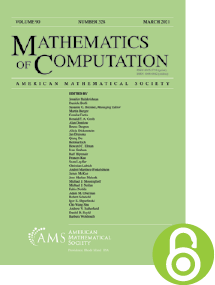Primes that become composite after changing an arbitrary digit
HTML articles powered by AMS MathViewer
- by Michael Filaseta and Jeremiah Southwick HTML | PDF
- Math. Comp. 90 (2021), 979-993 Request permission
Abstract:
We show that a positive proportion of the primes have the property that if any one of its digits in base $10$, including its infinitely many leading $0$ digits, is replaced by a different digit, then the resulting number is composite.References
- A. S. Bang, Taltheoretiske Undersøgelser, Tidsskrift for Mat., 4 (1886), 70–80, 130–137.
- John Brillhart, D. H. Lehmer, J. L. Selfridge, Bryant Tuckerman, and S. S. Wagstaff Jr., Factorizations of $b^n \pm 1$, 2nd ed., Contemporary Mathematics, vol. 22, American Mathematical Society, Providence, RI, 1988. $b=2,3,5,6,7,10,11,12$ up to high powers. MR 996414, DOI 10.1090/conm/022
- Peter Orno, James Propp, Alan Wayne, J. Phipps McGrath, Leon Gerber, Howard Eves, Murray S. Klamkin, Paul Erdos, H. Kestelman, Zane C. Motteler, Marlow Sholander, Richard Beigel, and Stanley J. Benkoski, Problems, Math. Mag. 52 (1979), no. 3, 179–184. MR 1572304
- Michael Filaseta, Mark Kozek, Charles Nicol, and John Selfridge, Composites that remain composite after changing a digit, J. Comb. Number Theory 2 (2010), no. 1, 25–36 (2011). MR 2895985
- H. Halberstam and H.-E. Richert, Sieve methods, London Mathematical Society Monographs, No. 4, Academic Press [Harcourt Brace Jovanovich, Publishers], London-New York, 1974. MR 0424730
- Jackson Hopper and Paul Pollack, Digitally delicate primes, J. Number Theory 168 (2016), 247–256. MR 3515817, DOI 10.1016/j.jnt.2016.04.007
- Dan Ismailescu and Peter Seho Park, On pairwise intersections of the Fibonacci, Sierpiński, and Riesel sequences, J. Integer Seq. 16 (2013), no. 9, Article 13.9.8, 9. MR 3137937
- Murray S. Klamkin, G. Edgar, Richard A. Gibbs, R. P. Boas, Bernardo Recaman, Paul Erdos, Jeffrey Shallit, Danny Goldstein, Sidney Penner, St. Olaf Problem Group, W. Weston Meyer, L. Carlitz, and Richard Scoville, Problems, Math. Mag. 51 (1978), no. 1, 69–72. MR 1572252
- S. V. Konyagin, Numbers that become composite after changing one or two digits, Pioneer Jour. of Algebra, Number Theory and Appl. 6 (2013), 1–7.
- Neil J. A. Sloane, The on-line encyclopedia of integer sequences, Notices Amer. Math. Soc. 65 (2018), no. 9, 1062–1074. MR 3822822
- Jeremiah T. Southwick, Two Inquiries Related to the Digits of Prime Numbers, ProQuest LLC, Ann Arbor, MI, 2020. Thesis (Ph.D.)–University of South Carolina. MR 4144492
- Cameron L. Stewart, On divisors of Lucas and Lehmer numbers, Acta Math. 211 (2013), no. 2, 291–314. MR 3143892, DOI 10.1007/s11511-013-0105-y
- Terence Tao, A remark on primality testing and decimal expansions, J. Aust. Math. Soc. 91 (2011), no. 3, 405–413. MR 2900615, DOI 10.1017/S1446788712000043
- K. Zsigmondy, Zur Theorie der Potenzreste, Monatsh. Math. Phys. 3 (1892), no. 1, 265–284 (German). MR 1546236, DOI 10.1007/BF01692444
Additional Information
- Michael Filaseta
- Affiliation: Department of Mathematics, University of South Carolina, Columbia, South Carolina 29208
- MR Author ID: 66800
- Email: filaseta@math.sc.edu
- Jeremiah Southwick
- Affiliation: Department of Mathematics, University of South Carolina, Columbia, South Carolina 29208
- ORCID: 0000-0003-0751-8358
- Email: soutjt14@alumni.wfu.edu
- Received by editor(s): January 13, 2020
- Received by editor(s) in revised form: January 30, 2020, and July 29, 2020
- Published electronically: November 24, 2020
- © Copyright 2020 American Mathematical Society
- Journal: Math. Comp. 90 (2021), 979-993
- MSC (2020): Primary 11Y11; Secondary 11A63, 11N36, 11P32, 11Y05
- DOI: https://doi.org/10.1090/mcom/3593
- MathSciNet review: 4194171


